Real World DirectX 10 Performance: It Ain't Pretty
by Derek Wilson on July 5, 2007 9:00 AM EST- Posted in
- GPUs
DirectX 9 vs. DirectX 10
Here we'll take a closer look at some of the scaling differences between DirectX 9 and DirectX 10 on current hardware under current drivers with Company of Heroes and Lost Planet.
First up is a look at relative scaling between cards under each API. The idea is to see whether cards that perform better under DX9 also perform better under DX10 (and vice versa). This will only give us a glimpse at what could happen going forward, as every game (and every implementation of that game) will be different.
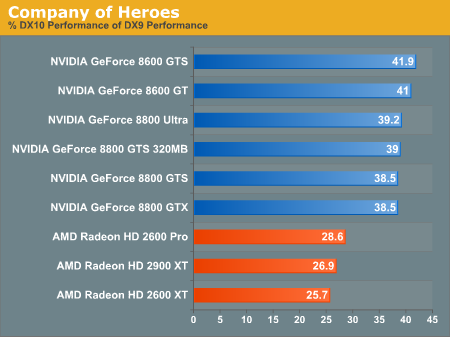
For Company of Heroes, we see huge performance drops in moving to DirectX 10 from DirectX 9. The new lighting and shadowing techniques combined with liberal geometry shader use are responsible for at least halving performance when running the more detailed DX10 path. NVIDIA seems to handle the new features Relic added better than AMD. These results are especially impressive remembering that NVIDIA already outperformed AMD hardware under DX9.
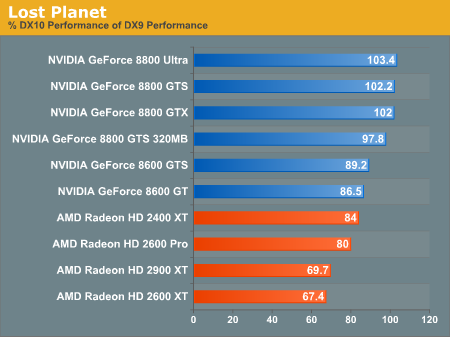
Lost Planet is a completely different animal. With Capcom going for a performance boost under DX10, we can see that they actually succeeded with the top of the line NVIDIA cards. There isn't much else enticing about the DX10 version of Lost planet, and it's clear that AMD's drivers haven't been optimized to tackle this game quite yet.
Next we want to take a look at AA scaling difference between DirectX 9 and DirectX 10. Can we expect less impact from AA on one API or the other? Let's take a look.
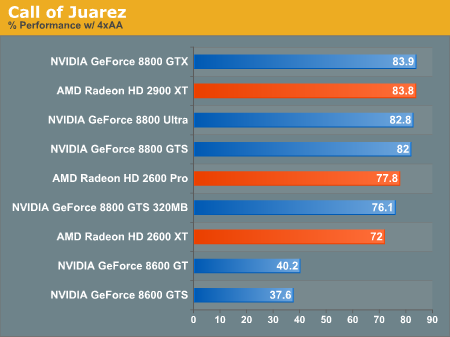
Under Call of Juarez, our low-end NVIDIA cards suffer from a huge drop in performance when AA is enabled. This is likely due to the fact that they can't handle either the bandwidth or the shader requirements of Techland's HDR correct AA. The higher end parts seem to handle the AA method fairly well, though certainly NVIDIA would be happier if the retained their hardware AA advantage.
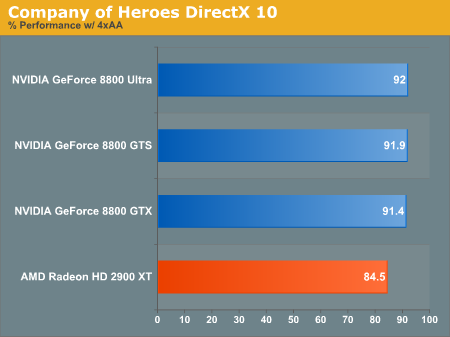
For our DX10 Company of Heroes test, which does use hardware MSAA resolve where available, AMD hardware scales much worse than NVIDIA hardware.
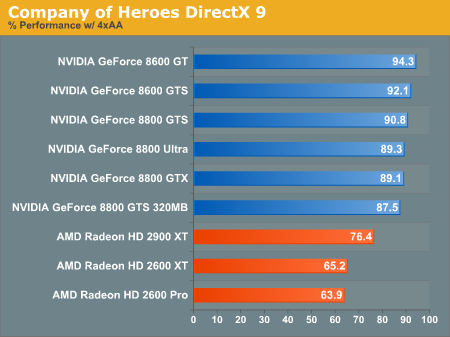
All of our cards scale worse under DX9 when enabling 4xAA than under DX10. While we don't have enough information to really understand why that is under Company of Heroes, it is certainly interesting to see some sort of across the board performance advantage for DX10 (even if it is in a round about way).

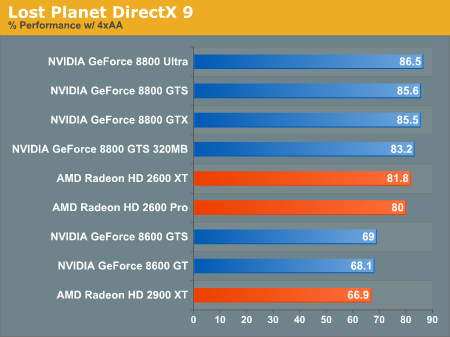
Lost Planet, with its attempt to improve performance by moving to DX10, delivers very similar performance impact from AA in either DX9 or DX10. Again we see a very slight scaling advantage in favor of DX10 (especially with AMD hardware), but nothing life changing.
Here we'll take a closer look at some of the scaling differences between DirectX 9 and DirectX 10 on current hardware under current drivers with Company of Heroes and Lost Planet.
First up is a look at relative scaling between cards under each API. The idea is to see whether cards that perform better under DX9 also perform better under DX10 (and vice versa). This will only give us a glimpse at what could happen going forward, as every game (and every implementation of that game) will be different.

For Company of Heroes, we see huge performance drops in moving to DirectX 10 from DirectX 9. The new lighting and shadowing techniques combined with liberal geometry shader use are responsible for at least halving performance when running the more detailed DX10 path. NVIDIA seems to handle the new features Relic added better than AMD. These results are especially impressive remembering that NVIDIA already outperformed AMD hardware under DX9.

Lost Planet is a completely different animal. With Capcom going for a performance boost under DX10, we can see that they actually succeeded with the top of the line NVIDIA cards. There isn't much else enticing about the DX10 version of Lost planet, and it's clear that AMD's drivers haven't been optimized to tackle this game quite yet.
Next we want to take a look at AA scaling difference between DirectX 9 and DirectX 10. Can we expect less impact from AA on one API or the other? Let's take a look.

Under Call of Juarez, our low-end NVIDIA cards suffer from a huge drop in performance when AA is enabled. This is likely due to the fact that they can't handle either the bandwidth or the shader requirements of Techland's HDR correct AA. The higher end parts seem to handle the AA method fairly well, though certainly NVIDIA would be happier if the retained their hardware AA advantage.

For our DX10 Company of Heroes test, which does use hardware MSAA resolve where available, AMD hardware scales much worse than NVIDIA hardware.

All of our cards scale worse under DX9 when enabling 4xAA than under DX10. While we don't have enough information to really understand why that is under Company of Heroes, it is certainly interesting to see some sort of across the board performance advantage for DX10 (even if it is in a round about way).


Lost Planet, with its attempt to improve performance by moving to DX10, delivers very similar performance impact from AA in either DX9 or DX10. Again we see a very slight scaling advantage in favor of DX10 (especially with AMD hardware), but nothing life changing.










59 Comments
View All Comments
jay401 - Friday, July 6, 2007 - link
They're right though, the charts need work. They are not intuitive and there are multiple better ways to present 'percent change' data that would make sense on first glance without the reader having to decipher an unintuitive method that is contrary to the readability of the article.DerekWilson - Friday, July 6, 2007 - link
The dx9 vs dx10 scaling graphs have been altered to present the data in a different way.Please let me know if this is still not adequate.
Andyvan - Thursday, July 5, 2007 - link
I had the exact same reaction to the charts. For the Lost Planet chart with the two colors, either pick better (more standard) colors, or make the performance drop bars grow to the left (or down), and the performance increase bars grow to the right (or up).-- Andyvan
PrinceGaz - Thursday, July 5, 2007 - link
The best thing to do with those charts is change them to show relative performance in DX10 compared to DX9, with 100% meaning no change (same performance in DX10 as DX9). Improvements with DX10 give scores above 100%, reduced performance gives a result below 100%.Doing that would make the graphs much easier to understand than the current mess.
sterlinglittle - Thursday, July 5, 2007 - link
This might be a silly question as I can't recall the current status of MultiGPU performance with Vista drivers. Will it be possible to test these games with SLI/CrossFire configurations soon?gigahertz20 - Thursday, July 5, 2007 - link
The results show exactly why I am waiting to buy a DX10 video card, all these people who rushed out to buy a Geforce 8800GTX or AMD 2900XT..hah..especially all those 2900XT fanboys who said the R600 would destroy the 8800GTX in DX10 benchmarks because it has 320 stream processors and a 512-bit memory interface....well guess what, the benchmarks are in and they show the R600 is still the power hunry POS video card it is.KeithTalent - Thursday, July 5, 2007 - link
I'm not sure how it is a 'hah' to the people that purchased these cards as they still blow everything else out of the water in DX9, I mean it is not even close.So for those of us running at higher resolutions (1920x1200 or higher), an 8800/2900 or two made perfect sense (and still does). I doubt very many people were expecting great DX10 performance right away anyway, particularly as the games available barely make use of it.
KT
Sceptor - Thursday, July 5, 2007 - link
I agree with your idea, I've always skipped over one generation of hardware to another.Especially when users are still "testing" Vista gaming for Microsoft, Nvidia and AMD I see no need to part with my money until performance is at least on par with DX9.
Good article...Nice to see some real numbers on DX10 vs DX9
DerekWilson - Thursday, July 5, 2007 - link
there are applications where the 2900 xt does outperform its competition, as is shown by call of juarez.it really depends on how developers go forward. we'll have to wait and see what happens. judging the future of AMD/NVIDIA competition under dx10 isn't really feasible with only 3 apps to go by.
one thing's for sure though, we'd love to see better performance out of the mainstream parts from both camps. And having some parts to fill in the gap between the lower and higher end hardware would be nice too.
defter - Thursday, July 5, 2007 - link
I think the point here is that many claimed that "R6xx is designed for DX10, don't judge it based on DX9 performance blah blah blah". Those claims gave the impression, that relative DX10 performance of R6xx series will be much better than their DX9 performance.Your tests show that on average, R6xx takes a HIGHER performance hit from moving to DX10. Thus, under DX10 R6xx is even SLOWER than it was under DX9.